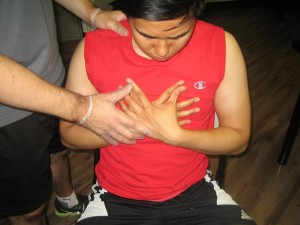Pneumothorax or a collapsed lung occurs once the air that normally circulates inside the lung leaks into the space in between the lung and the chest wall which is called the pleural space. The accumulation of air increases the pressure on the lung, thus causing it to collapse. In most circumstances, only a region of the lung collapses while leaving the rest intact.
Once pneumothorax occurs, the lung could not fully expand normally when breathing in. This results to shortness of breath and chest pain. If the collapse of the lung is severe, it can cause the following:
- Shock
- Diminished level of blood oxygen
- Cardiac arrest
- Respiratory failure
Remember that a collapsed lung is a serious condition that can be dangerous if it is not promptly treated.
Causes
Pneumothorax can be due to damage to the lungs, air blisters inside the lung or trauma to the chest region.
Lung tissue damage
The impaired lung tissue can cause pneumothorax. The damaged tissue is not as strong as the healthy ones, thus it is prone to easily collapse. The damage can be caused by infections and lung diseases such as:
- Pneumonia
- Tuberculosis
- Lung cancer
Sustaining trauma to the chest can lead to a collapsed lung. - Cystic fibrosis
- Pulmonary fibrosis
- Sarcoidosis
Trauma
Sustaining trauma to the chest can lead to a collapsed lung. The common traumatic events include:
- Gunshot wound
- Rib fracture
- Strong blow to the chest
- Puncture wound from a knife
- Lung biopsy
- Vigorous CPR
- Endoscopy procedures
Air blebs
The air blebs are small-sized blisters filled with air that develop on the exterior lining of the lungs. Oftentimes, these air blisters break and release air into the pleural space, thus causing the lung to collapse. This is likely due to changes in the air pressure.
What are the indications of pneumothorax?
Once pneumothorax initially occurs, there is a sharp pain in the chest that worsens while coughing. There is also difficulty breathing or shortness of breath. An individual can also experience other symptoms if a larger region of the lung is affected such as the following:
- Bluish tinge on the skin
- Rapid heart rate
- Flaring nostrils while breathing
- Easily tired
- Chest tightness
- Low blood pressure
Pneumothorax must be managed as a medical emergency. Even though the symptoms are mild, call for emergency assistance or bring the individual to the nearest emergency department.
Management
The treatment for pneumothorax is aimed on restoring the lung function by eliminating the external pressure on the lung.
In mild cases, treatment is not usually required. The doctor will monitor the condition to ensure that it improves over time. A chest X-ray is carried out several times throughout the course of monitoring. Supplemental oxygen can also be given to help the lungs recover which is administered via a mask. It is vital to get plenty of rest to hasten the recovery process.

